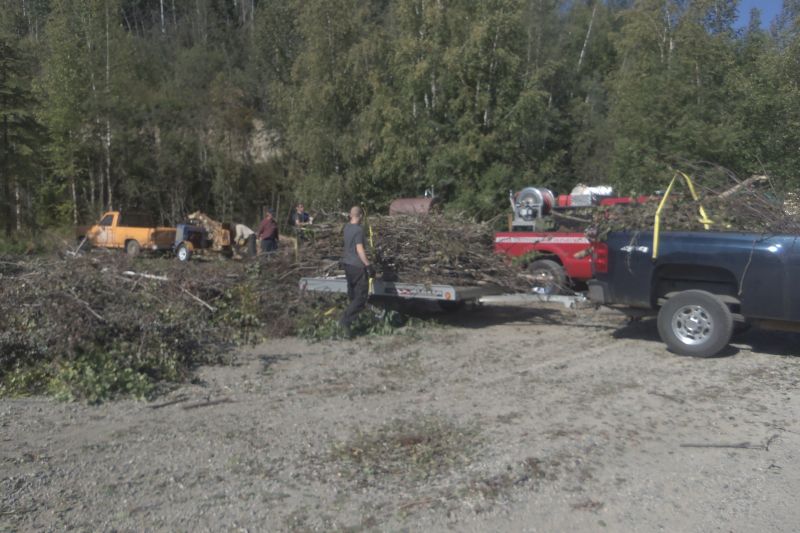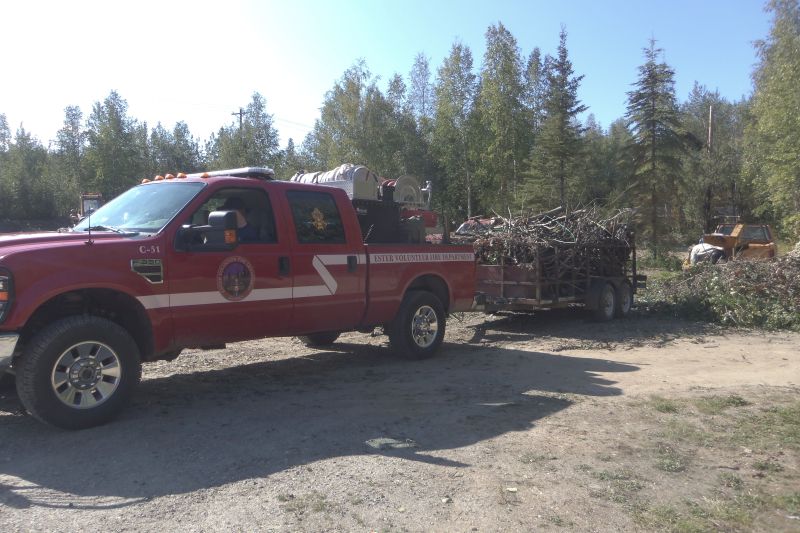Firewise is a cooperative effort among local, state, federal and private agencies and organizations to promote fire safety in the wildland/urban interface. Firefighters do not have the resources to defend every home during a wildfire. When adequately prepared, a house can withstand a wildland fire without the intervention of the fire service. In fact, a house and its surrounding community can be both Firewise and compatible with the area's ecosystem. The Firewise Communities/USA program enables communities in all parts of the United States to achieve a high level of protection against wildland/urban interface fire as well as sustainable ecosystem balance. Firewise Communities/USA program provides residents of the wildland/urban interface with the knowledge and skill necessary to make it happen.
Firewise Communities/USA is a unique opportunity available to America's fire prone communities. Its goal is to encourage and acknowledge action that minimizes home loss do to wildfire. It teaches you to prepare for a fire before it occurs. The program adapts especially well to small communities, developments and residential home associations of all types.
Firewise Communities/USA is sponsored by the National Wildfire Coordinating Group.
How to become an Alaska Firewise Community
Determine if the community is at risk
Becoming recognized as a Firewise Community/USA begins with the community itself. A community representative can complete an on-line form on the Firewise Communities/USA web site, http://www.firewise.org/usa or contact Sarah Saarloos at (907) 269-8471.
The community needs to enlist a wildland/urban interface (WUI) specialist to complete a community assessment and assist in creating a plan (Community Wildfire Protection Plan) that identifies agreed-upon achievable solutions to be implemented by the community. The visit is coordinated with local fire officials. You can contact your nearest Alaska Division of Forestry & Fire Protection Office, borough or municipality wildfire mitigation office to arrange for a specialist to conduct the assessment.
Organize a Firewise Board
If it is determined the community has homes in the wildland/urban interface that are considered at risk, community representatives will create a multi-discipline Firewise Board, Firewise Task Force or Commission that should include homeowners, fire professionals and/or members of other interest groups such as planners, land managers, and urban foresters.
Develop a Community Wildfire Protection Plan
Upon completion of the site assessment and evaluation of the community's readiness to withstand a WUI fire, the WUI specialist schedules a meeting with the local Firewise board. The assessment and evaluation are presented for review and acceptance. If the site assessment and evaluation are acceptable, the Firewise board will use them as a basis for developing a Community Wildfire Protection Plan that contains agreed-upon, area-specific solutions to its wildfire issues. Board members should be informed that developing a Community Wildfire Protection Plan (CWPP) can be a six month process.
Sponsor an event
The Community Wildfire Protection Plan contains specific action items that can be implemented by homeowners with assistance from fire staff or other sources. When they are executed, they are called "Firewise Days." A Firewise Day must be held each year in order to maintain recognition status. Firewise Days can include chipping days, public awareness events, brush cleanup and so forth.
Invest a minimum of $2/capita
Firewise Communities are able to quantify their concern about the wildfire issue. To this end, they are willing to invest $2/capita in Firewise projects each year. This means that in a community of 200 residents, $400 will be invested in projects named in the plan prepared by the Firewise board. Volunteer hours, use of equipment, and time spent by agency fire staff can be included in this figure, as can state or federal grant dollars.
Certification as a Firewise Community/USA
Firewise Communities/USA recognition status is achieved when the community has completed and signed Community Wildfire Protection Plan and after the community has completed one Firewise project. At that time, a Board member can download the Firewise Communities/USA application form from the program's web site, http://www.firewise.org/usa. The completed application is to be submitted to the Alaska Firewise Community Liaison. Upon certification by the Alaska State Forester, the Firewise Communities Liaison forwards the completed application to the national Firewise program office. A special ceremony will be held in the community after certification as a Firewise Community/USA with all agencies and organizations involved in the process.
Continued Certification
A permanent Firewise board is created that will maintain the program into the future. A mitigation project (reduction of risks to homes) must be completed during the year for recertification. Recognition renewal must be completed by December 31 each year. Recognized communities submit documentation indicating continued community participation to the Firewise Community Liaison. Renewal forms are downloadable at http://www.firewise.org/usa.
Current Alaskan Firewise Communities
Horseshoe Lake
The community of Horseshoe Lake was recognized as a Firewise Community June 15, 2006 on the 10th anniversary of the Miller's Reach fire. Horseshoe Lake is now in its sixth year of Firewise Community recognition. In addition Cathi Kramer, the community ’spark plug’, received national recognition for her local efforts to reduce wildfire loss. Congratulations to Cathi!
Horseshoe Lake is a residential community of 246 properties with 157 homes and other structures. The community is located within the larger, unincorporated community of Big Lake, Alaska. The area began attracting recreational development in the form of small cabins in the 1950s. The Horseshoe Lake community was heavily impacted by 1996 Miller's Reach fire with many residents losing their homes and surrounding forest to wildland fire. What was once a scattering of homes nestled among spruce forest at the edges of the lake has become a community of modern, re-built homes standing proud among the regenerating wildlands. The community publishes a local directory which includes the locations of fire pumps, hose, and homeowner firefighting tools and capabilities. They meet on regular basis to discuss common interests. Primary among those shared concerns is wildfire protection.
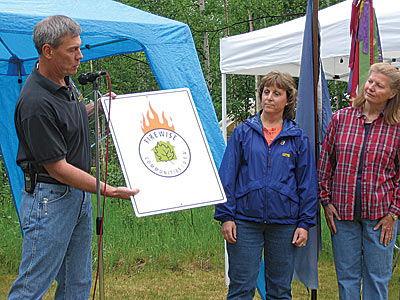
Ken Bullman, Mat Su Area Forester, presents community activists and Firewise Board members Cathi Kramer & Louise Kucera with Firewise Communities/USA signage.
The community held its very first "Firewise Day" event during the week of May 1-7, 2006 by cleaning up brush and trash in and around homes and distributing Firewise materials. On June 15th 2006 in conjunction with the recognition ceremony, a Community Education Day was held which encouraged community members to participate in the Firewise Program to protect themselves and their neighbors. Since then the community has held Firewise Days every year and engaged residents, young and old alike, in reducing wildfire risk.
For more information on the Horseshoe Lake Firewise Community and their activities, including annual Firewise Days please visit their web site at http://hsfirewise.org/index.php
 From left to right: Michieal Abe’, Michelle Torres & Bea Adler of the Mat Su Borough Department of Emergency Services/Wildfire Mitigation Office , Cathi Kramer of Horseshoe Lake Firewise Community and Tom Greiling of the Division of Forestry & Fire Protection during the National Fire Protection Agency (NFPA) Firewise Communities/USA program visit, October 2012.
From left to right: Michieal Abe’, Michelle Torres & Bea Adler of the Mat Su Borough Department of Emergency Services/Wildfire Mitigation Office , Cathi Kramer of Horseshoe Lake Firewise Community and Tom Greiling of the Division of Forestry & Fire Protection during the National Fire Protection Agency (NFPA) Firewise Communities/USA program visit, October 2012.
Kennicott/McCarthy
Kennicott/McCarthy is a small community uniquely situated deep in the heart of the Wrangell-St Elias National Park and Preserve. It is one of the most remotely populated communities on the US road system. The area has a history of large fires and although the community has some natural barriers it is encompassed by miles of black and white spruce. Dead/down hardwoods have increased the fuel loading and dry grasses greatly increase the threat of wildland fire.
In 2011 a Community Wildfire Protection Plan was completed in collaboration with the local volunteer fire department, National Park Service and Alaska Division of Forestry & Fire Protection. In 2012 the Division of Forestry & Fire Protection received a competitive Western Wildland Urban interface grant to reduce the hazardous fuels in and around the community through a land owner cost share grant program, the construction of shaded fuel breaks and a Firewise educational outreach campaign. The community has embraced Firewise concepts with open arms, creating their own Firewise logo helping to contact absentee landowners, educating themselves and those around them, planning caches of fire suppression equipment within subdivisions and finding solutions to their hazards as unique as the community itself. The community was in turn motivated to form a Firewise Board and held their first Firewise Day on May 31, 2014. A drawing was held in which each person who entered the drawing dedicated two hours of their time to assist the lucky winner in Firewise activities around their home. Nine families signed up for the drawing and nine citizens and ten agency people spent two hours cutting and chipping brush. Firewise educational materials and free larch and birch trees were distributed. The chipper and saw used was donated by the Alaska Division of Forestry & Fire Protection. National Firewise Communities/USA recognition status was achieved on August 14, 2014. Congratulations Kennicott/McCarthy!
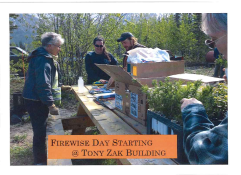
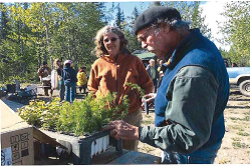
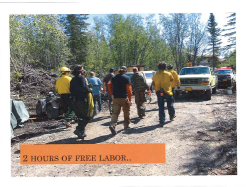
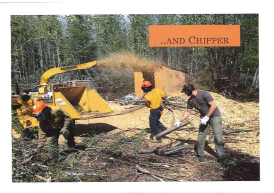

Ester Lump
Ester is a small community located eight miles west of Fairbanks, Alaska. Ester is covered by the Fairbanks North Star Borough Community Wildfire Protection Plan (CWPP) and has been identified as a community at risk for wildfire. Recognizing this risk, The Ester community Council, Ester Volunteer Fire Department community volunteers organized a Firewise Board and planned their Firewise Day for August 23rd.
Summer long outreach and education included staff and volunteers going door to door distributing door hangers and packages of selected Firewise materials to each resident of Ester Lump road service area with approximately forty-five residences. Follow up phone calls were made as well as flyers and signage in strategic locations advertising the community Firewise Day. Motivated property owners received Firewise home assessments and cleared underbrush in an estimated thirty foot radius around their homes and properties. The Ester Community Association, Tanana Truck and Tractor, Ester Volunteer Fire Department and the Alaska Division of Forestry & Fire Protection all contributed to the program. Trucks and trailers were available to remove the residential brush piles and the debris was transported to the Ester Community Park where the use of a wood chipper was donated by Phil Rulon and Scott Allen. The debris was chipped for use as mulch in several locations around the park. Refreshments were provided with donated funds to all of the volunteers.
Ester Lump was officially recognized as a Firewise Community/USA on September 23, 2014. Congratulations and good job!
